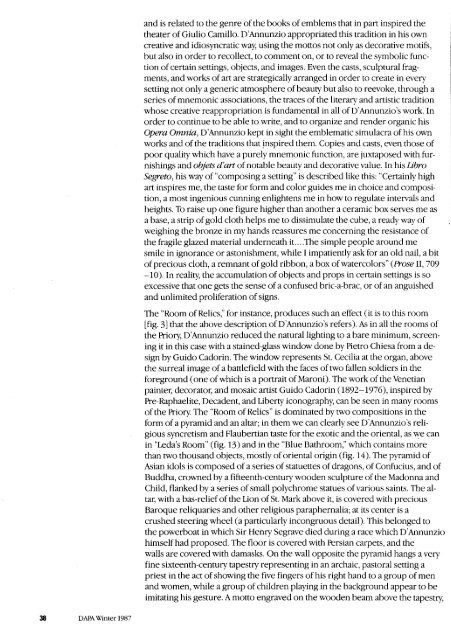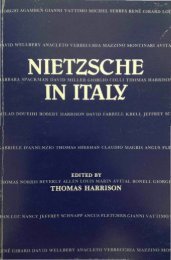The Journal of Decorative and Propaganda Arts - UCLA Department ...
The Journal of Decorative and Propaganda Arts - UCLA Department ...
The Journal of Decorative and Propaganda Arts - UCLA Department ...
You also want an ePaper? Increase the reach of your titles
YUMPU automatically turns print PDFs into web optimized ePapers that Google loves.
38 DAPAWinter 1987<br />
<strong>and</strong> is related to the genre <strong>of</strong> the books <strong>of</strong> emblems that in part inspired the<br />
theater <strong>of</strong> Giulio Camillo. D'Annunzio appropriated this tradition in his own<br />
creative <strong>and</strong> idiosyncraticway, using the mottos not only as decorative motifs,<br />
but also in order to recollect, to comment on, or to reveal the symbolic function<br />
<strong>of</strong> certain settings, objects, <strong>and</strong> images. Even the casts, sculptunlfragments,<br />
<strong>and</strong> works <strong>of</strong> art are strategically arranged in order to create in every<br />
setting not only a generic atmosphere <strong>of</strong> beauty but also to reevoke, through a<br />
series <strong>of</strong> mnemonic associations, the traces <strong>of</strong> the literary <strong>and</strong> artistic tradition<br />
whose creative reappropriation is fundamental in all <strong>of</strong> D'Annunzio's work. In<br />
order to continue to be able to write, <strong>and</strong> to organize <strong>and</strong> render organic his<br />
Opera Omnia, D'Annunzio kept in sight the emblematic simulacra <strong>of</strong> his own<br />
works <strong>and</strong> <strong>of</strong> the traditions that inspired them. Copies <strong>and</strong> casts, even those <strong>of</strong><br />
poor quality which have a purely mnemonic function, are iuxtaposed with furnishings<br />
<strong>and</strong> objets d'arr <strong>of</strong> notable beauty <strong>and</strong> decorative value. In his Libro<br />
Segreto, his way <strong>of</strong> "composing a setting" is described like this: "Cgrtainly high<br />
art inspires me, the taste for form <strong>and</strong> color guides me in choice <strong>and</strong> composition,<br />
a most ingenious cunning enlightens me in how to regulate intervals <strong>and</strong><br />
heights. To raise up one figure higher than another a ceramic box serves me as<br />
a base, a strip <strong>of</strong> gold cloth helps me to dissimulate the cube, a ready way <strong>of</strong><br />
weighing the bronze in my h<strong>and</strong>s reassures me concerning the resistance <strong>of</strong><br />
the fragile glazedmateri^l underneath it....<strong>The</strong> simple people around me<br />
smile in ignorance or astonishment, while I impatiently ask for an old nail, a bit<br />
<strong>of</strong> precious cloth, a remnant <strong>of</strong> gold ribbon, a box <strong>of</strong> watercolors" (ProseII,709<br />
-10). In reality, the accumulation <strong>of</strong> objects <strong>and</strong> props in certain settings is so<br />
excessive that one gets the sense <strong>of</strong> a confused bric-a-brac, or <strong>of</strong> an anguished<br />
<strong>and</strong> unlimited proliferation <strong>of</strong> signs.<br />
<strong>The</strong> "Room <strong>of</strong> Relics," for instance, produces such an effect (it is to this room<br />
[fig. 3] that the above description <strong>of</strong> D'Annunzio's refers). As in all the rooms <strong>of</strong><br />
the Priory D'Annunzio reduced the natural lighting to abare minimum, screening<br />
it in this case with a stained-glass window done by Pietro Chiesa from a design<br />
by Guido Cadorin. <strong>The</strong> window represents St. Cecilia at the organ, above<br />
the surreal image <strong>of</strong> a battlefield with the faces <strong>of</strong> two fallen soldiers in the<br />
foreground (one <strong>of</strong> which is a portrait <strong>of</strong> Maroni). <strong>The</strong> work <strong>of</strong> the Venetian<br />
painteq decorator, <strong>and</strong> mosaic artist Guido Cadorin (1892-1976), inspired by<br />
Pre-Raphaelite, Decadent, <strong>and</strong> Liberty iconography, can be seen in many rooms<br />
<strong>of</strong> the Priory <strong>The</strong> "Room <strong>of</strong> Relics" is dominated by two compositions in the<br />
form <strong>of</strong> a pyramid <strong>and</strong> an altar;in them we can clearly see D'Annunzio's religious<br />
syncretism <strong>and</strong> Flaubertian taste for the exotic <strong>and</strong> the oriental, as we can<br />
in "Leda's Room" (fig. 13) <strong>and</strong> in the "Blue Bathrooml'which contains more<br />
than two thous<strong>and</strong> objects, mostly <strong>of</strong> oriental origin (tig. 14). <strong>The</strong> pyramid <strong>of</strong><br />
Asian idols is composed <strong>of</strong> a series <strong>of</strong> statuettes <strong>of</strong> dragons, <strong>of</strong> Confucius, <strong>and</strong> <strong>of</strong><br />
Buddha, crowned by a fifteenth-centurywooden sculpture <strong>of</strong> the Madonna <strong>and</strong><br />
Child, flanked by a series <strong>of</strong> small polychrome statues <strong>of</strong> various saints. <strong>The</strong> altar,<br />
with a bas-relief <strong>of</strong> the Lion <strong>of</strong> St. Mark above it, is coveredwith precious<br />
Baroque reliquaries <strong>and</strong> other religious paraphernalia; at its center is a<br />
crushed steering wheel (a particularly incongruous detail). This belonged to<br />
the powerboat in which Sir Henry Segrave died during a race which D'Annunzio<br />
himself had proposed. <strong>The</strong> floor is covered with Fersian carpets, <strong>and</strong> the<br />
walls are covered with damasks. On the wall opposite the pyramid hangs a very<br />
fine sixteenth-century tapestry representing in an archaic, pastoral setting a<br />
priest in the act <strong>of</strong> showing d-re five fingers <strong>of</strong> his right h<strong>and</strong> to a group <strong>of</strong> men<br />
<strong>and</strong> women, while a group <strong>of</strong> children playing in the background appear to be<br />
imitating his gesture. Amotto engraved on the wooden beam above the tapestry




